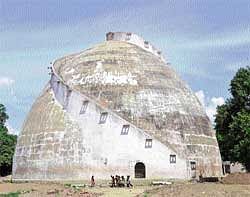Ready to get a facelift
When famine stuck parts of north India in 1770, it left hundreds of people dead and several thousands starved. Alarmed over the natural calamity, Capt John Garstin of the British Army decided to build a huge granary which could store truck-loads of foodgrains.

By 1786, the 29-metre high Golghar was constructed near the banks of the Ganga and ready to be used for storage. But strangely enough, it was never used as a granary. Reason: It had an architectural fault. Its doors opened inward. As a consequence, it was impossible to open it once the granary was full.
The huge structure, whose walls are 3.6 metre thick at the base and which has 145 steps, eventually became a prime tourists’ draw as one can get a panoramic view of the city from the top.
More than two centuries after it was constructed, the historical site is today in a dilapidated condition. It has not only developed vertical cracks near the staircase, but also its foundation, too, has been affected due to constant water-logging.
Experts from Indian Institute of Technology (IIT), Delhi, were roped in, who, in turn, suggested immediate revamp and renovation work to protect the monument. The State Government assigned the job to the ASI and sanctioned Rs 94 lakh to carry out the restoration work.
Since the adjoining roads near Golghar are situated at a higher level, water-logging near the structure is a constant problem. Engineering experts argued that accumulation of water near the base was resulting in deposits due to capillary action, which, in turn, was eating away the bricks and lime-surkhi plaster used in it, thereby weakening the entire structure.
Experts suggested that the bearing capacity of the soil near the foundation should also be checked. They argued that lead sheets should be put beneath the surface, which could check percolation of water to the lower levels of the soil.
“So far as the restoration of the superstructure is concerned, we will use the
latest pressure grouting technique of restoring old buildings in which cracks are filled,” said a senior ASI official.
In this technique, the outer part of the crack is covered with a clay layer. A mixture of building material, used in the original structure, is pumped at high pressure using a pipe to fill the gaps. Once the material settles down, the clay cover is removed. After the completion of the filling work, the outer and inner parts of the crack are stitched using old bricks so that the walls retain the original shape. The existing plaster cover of the outer wall will be replaced with a fresh cover of the same thickness. Now, the thickness of the plaster cover is more than what it was in the original structure.
The entire renovation work is likely to take a year. Till then, the city’s major tourist attraction will be closed for visitors, who, over the years, have rubbed shoulders with each other to climb its 145 steps to reach the top of the dome structure from where they could get a clear view of the State Capital.
Deccan Herald is on WhatsApp Channels| Join now for Breaking News & Editor's Picks